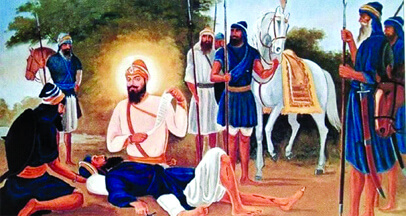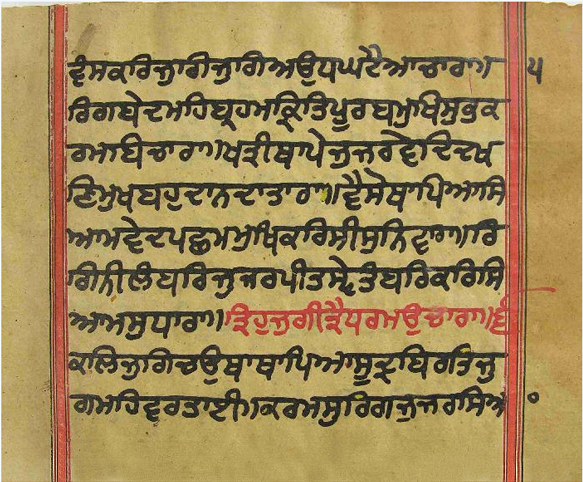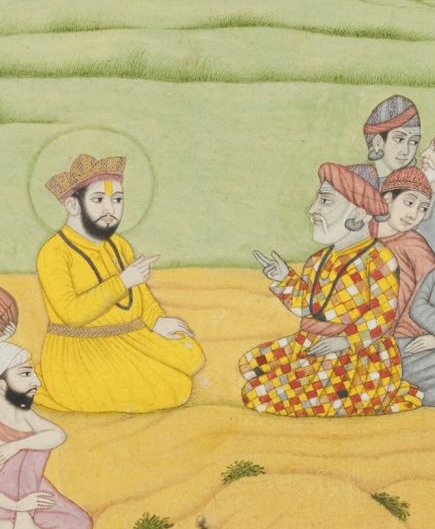AKUL, BHAI, a resident of Sultan pur Lodhi in present day Kapurthala district of the Punjab, embraced the Sikh faith in the time of Guru Amar Das. Bhai Gurdas in his Varan praises his sincerity and devotion to the Guru. Once Bhai Akul, along with several others from his village, waited on Guru Arjan and begged to be instructed in how sattvika gunas, or qualities of purity and goodness, might be cultivated.
BAGHAR SINGH, BHAI, killed in 1740, was the youngest son of Bhai Alam Singh Nachna, of Duburji village in Sialkot district, a warrior in Guru Gobind Singh\'s retinue at Anandpur. His elder brothers, Mohar Singh and Amolak Singh, too, were soldiers and are believed to have died fighting along with their father in the battle of Chamkaur on 7 December 1705. As he grew up, Baghar Singh also joined the ranks of the Khalsa.
BHAGVAN DAS, BHAI, a devoted Sikh of Burhanpur (21° 18`N, 76° 14`E), on the bank of the River Tapti, once travelled to Amritsar along with Bhai Bodala, Bhai Malak Kataru, Bhai Prithi Mall, Bhai Bhagatu, Bhai Dallu, Bhai Sundar Das and Bhai Svami Das to seek instruction from Guru Hargobind. The Guru, says Bhai Mani Singh, Sikhan di Bhagat Mala, told them to construct a dharamsal in their town where they should gather morning and evening for prayer and to raise charities for the needy. He taught them to overcome their haumai, i.e. egoity, and to learn to be humble. Bhai Bhagvan Das and his companions followed the Guru`s instructions and established a sangat at Burhanpur to which Bhai Gurdas refers in his Varan, XI. 30.
BHULLA, BHAI, and Bhai Kulla, both Jhanjhi Sunars, accompanied by Bhagirath, a Soini Khatri, presented themselves before Guru Arjan and begged to be instructed in the pious way. The Guru told them, always to act like gurmukhs, and not like manmukhs. The Guru, according to Sikhan di Bhagat Mala, explained: "Gurmukhs are those who, turning their back on ego, heed the Guru`s word, who do not forget a good turn done to them but always forget anything done by themselves for the good of others. Still excelling gurmukhs are those who, having given up all ego, are good to others habitually, unmindful of how the others treat them.
BUDDH SINGH. BHAI (1903-1921), son of Bhai Surjan Singh and Mat Ganga Kaur was born on 4 January 1903 at village Kartarpur in Sialkot district. The family descended on the paternal side from Bhai Alam Singh Nachana, a prominent Sikh in Guru Gobind Singh`s retinue. Young Buddh Singh shared his elders` religious fervour and also received formal education up to the middle school standard. At the age of 15, he accompanied his parents on a pilgrimage to Sachkhand Sri Hazur Sahib, Nanded, where he received the vows of the Khalsa and donned a Nihang`s uniform. He organized a kirtanijatha (choir) and began preaching the Guru`s teachings.

CHALI MUKTE, lit. forty (chalf) liberated ones (mukte), is how a band of 40 brave Sikhs who laid down their lives fighting near the dhab or lake of Khidrana, also called Isharsar, on 29 December 1705 against a Mughal force in chase of Guru Gobind Singh are remembered in Sikh history and daily in the Sikh ardas or supplicatory prayer offered individually or at gatherings at the end of all religious services. Guru Gobind Singh, who had watched the battle from a nearby mound praised the martyrs` valour and blessed them as Chali Mukte, the Forty Immortals. After them Khidrana became Muktsar the Pool of Liberation.
CHUHAR, BHAI, Bhai Sam. Bhai Lala, all Sethi Khatris, and Bhai Nihalu were good musicians and had facility in expounding the holy hymns. Whenever they sang, discussed or discoursed on the sacred hymns, the sangat, records Bhai Mani Singh in his Sikhari di Bhagat Mala, felt deeply impressed. Guru Arjan appreciated their talent, too, and once spoke to them, "Good deeds are necessary along with a sweet voice.







